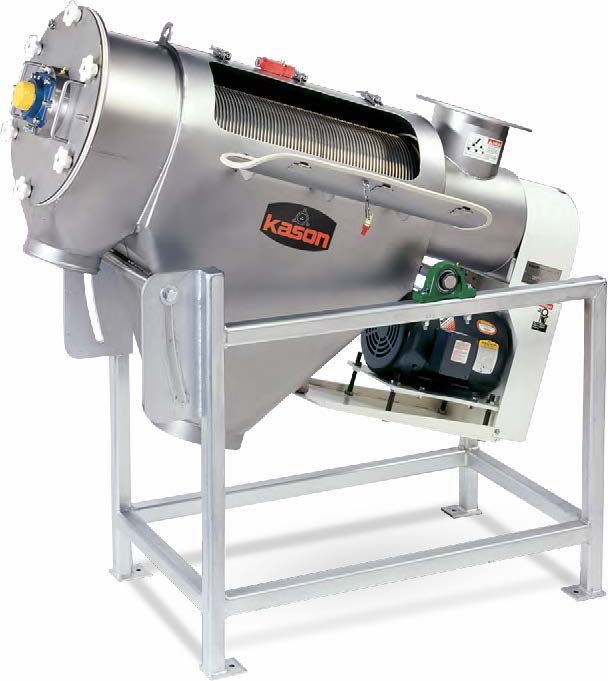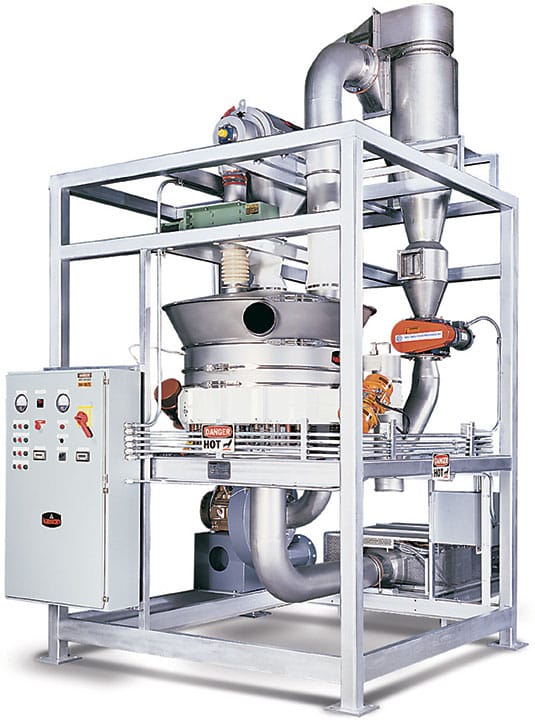Spent Grain Dryers
Spent grain dryers are the combination of centrifuges and fluid bed dryers, each customized for the application.
Spent grain is valuable for animal feed and some human food, but the moisture content destroys its shelf-life. To extract its value, distilleries and some breweries use equipment to dry spent grain immediately after collection.
Available Methods
Some distilleries use tumble (rotary) dryers, but these are not the right solution for this application due to the inherent nutrient degradation and risk of combustion caused by the heat. Belt dryers can also be used, but we find them to take too much space for the volume they can handle. The best solution was pioneered by Kason and perfected by Russell, and involves dewatering the spent with a centrifuge, then using a fluid bed dryer to finish the job.
Dewatering
The first step to dewatering spent grain is to use a specialized centrifugal sifter (Learn more about centrifugal sifters here). Unlike horizontal units that rely on short augers to feed standard centrifuges, the dewatering screener uses specialized components and can be inclined up to 40° to increase the dwell time of material within the chamber, increasing the drainage rate of free liquid. Raising the outlet end of the cylindrical chamber causes moisture to remain near the downhill inlet of the cylindrical screen, increasing the dryness of the discharged solids. Learn more about the dewatering step here.


After drying, we can package your spent grain into bulk bags, totes, or drums using bulk bag fillers.
Drying
The rest of the drying is done with a specialized circular fluid bed dryer. (Learn more about fluid bed dryers on abmequipment.com). Fluid bed dryers use a vibrating bed and upward draft of warm air to quickly dry spent grain while protecting the nutrients. Circular models are used instead of rectangular because they’re more efficient and easier to clean. It should be noted, however, that the drying step is significantly more expensive than the dewatering step and is only used in large breweries and distilleries.
Spent Grain Fluid Bed Dryer Benefits
- Takes moisture down to 13-9%
- Uniform drying of product
- Low footprint
- Energy-efficient
- Quick-Clean sanitary design
- Compliance with safety and sanitary standards
- (Comparatively) low-noise
- Casters (optional)
- Explosion-proof (optional)
Both the centrifuges and fluid bed dryers are available in a range of sanitary models and food-grade finishes that provide easy cleaning and maintenance, minimizing downtime between batches. All screening and dewatering equipment for distilleries is constructed with high-grade 304 and 316 stainless steel and can comply with global safety and sanitary standards.
Spent Grain Dryers for Animal Feed vs. Human Food
Dryers for animal feed and for human food are both available, with the difference being whether they use direct heat or indirect heat.
Direct Heat Dryers (Animal Feed)
Direct heat dryers expose the spent grain to the air from the heat source, like roasting a hot dog over a fire. This method is less expensive and more effective in reducing moisture content, but exposes the spent grain to the fire source. The reasons this method is usually used for animal feed are the following:
Oxides
Directly exposing spent grain to a fire source will cause some of it to be singed, resulting in some carbon monoxide. And because the heat source is usually petroleum-based, this means some nitrogen and sulfer oxides will get into the product. Not only are these not good for you, but they impact the flavor of the grain.
Nutrient Degredation
High and/or prolonged heat destroys nutrients. And with direct fire being a more dynamic process, some of the grain will get hotter than desired while other parts are still wet, resulting in some being burned by the end of the process. These incidents are almost always due to operator error, but the potential for it to happen is greater in direct heat than indirect heat dryers.
Fire Hazard
With spent grain being exposed to the heat source directly, naturally the chance of a fire is greater. Again, these incidents are almost always because of untrained personnel operating the equipment, but indirect heat is a more fail-safe method.
Indirect Heat Dryers (Human Food)
Indirect heat dryers rest the spent grain on a surface that’s heated by the heat source, like putting a hot dog on a skillet. This method is more expensive, but keeps the grain from being exposed to oxides from the fuel, protects the nutrients from degredation, and poses less of a fire hazard.
You may be wondering why people would pay more for indirect heat for human food products when we are exposed to all the risks of direct heat when we barbeque. First, indirect heat creates a more consistent product, which is important when your customers are humans passionate about nuances of flavor, and not cows. Second, using direct heat for human food products would restrict you to propane, when you could have more flexibility with indirect heat. Third, the standards for food production in your backyard or for cattle with a 2 year life expectancy are very different. When mass-producing food you want it to be as nutritious, clean, consistent, and healthy as possible.
Whether for human food or animal feed, our engineers will ensure your system produces a good final product. Give us a call or fill out a form to start your process today!
